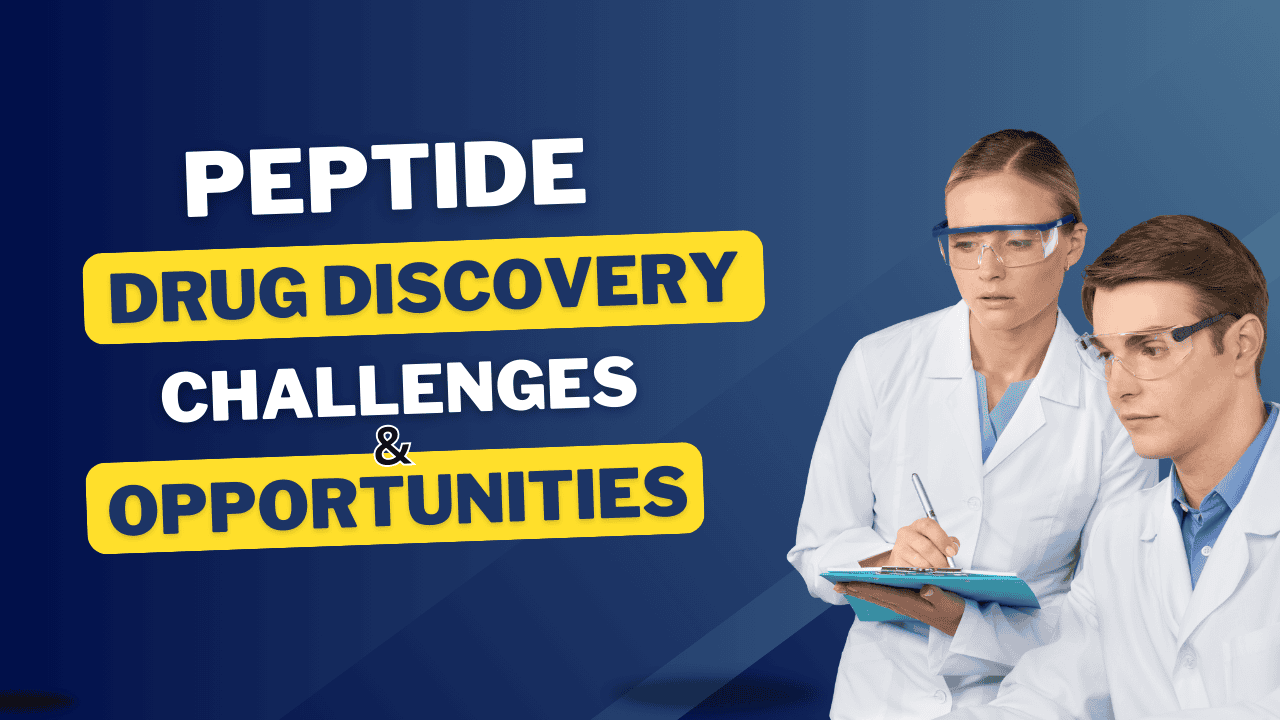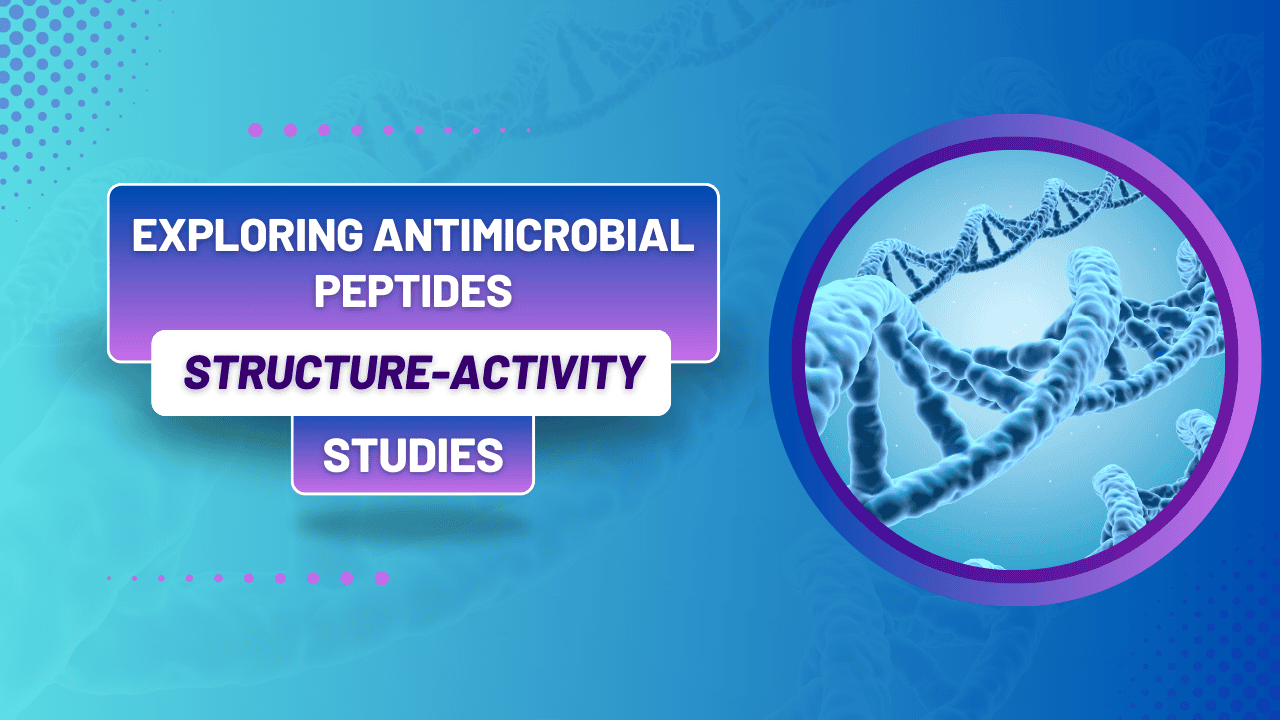

Peptide libraries have revolutionized drug discovery and design optimization, offering unprecedented diversity and efficiency in developing therapeutic peptides.
This article explores the latest advancements in peptide library screening methods, shedding light on their significance in creating optimized drug candidates.
You’ll understand why this topic is worth reading: it’s the backbone of modern medicinal chemistry, reshaping how new drugs are discovered and optimized!
Peptide libraries are a treasure trove for researchers in drug discovery. With the capability to present a vast array of peptide sequences, they open up avenues to identify novel peptide ligands and therapeutic peptides.
In the realm of modern medicine, peptide libraries act like a goldmine, each snippet of peptide sequence potentially holding the key to the next blockbuster drug. By offering a broad spectrum of peptide variations, these libraries expedite the hunt for bioactive peptides that can interact with various biological targets.
Imagine trying to find a needle in a haystack but having a magnet that only picks up the specific needle you’re after. The diversity within peptide libraries functions like this metaphorical magnet. Diverse peptide sequences increase the likelihood of identifying an optimal peptide that has high efficacy and specificity for its target.
Absolutely! Peptide libraries facilitate the rapid selection of cyclic peptides that are highly potent, stable, and specific—all crucial factors for effectiveness as a drug. This not only enhances the therapeutic potential but also minimizes side effects.
To understand why peptide libraries are so revolutionary, we first need to get a handle on peptides themselves. Think of peptides as the unsung heroes of molecular biology, quietly working behind the scenes to enact critical biological functions.
Peptides are short chains of amino acids, usually containing between 2 to 50 amino acids. In the context of drug discovery, these small but mighty molecules can mimic the structure and function of proteins, opening up new pathways for therapeutic intervention.
It’s all about the dance between structure and function. Peptides have a knack for adopting specific shapes and binding patterns that can latch onto proteins or receptors with high specificity. This peptide-protein or peptide-receptor interaction often leads to a desired biological response, such as inhibiting a disease pathway.
In some cases, yes! Because peptides originate from natural biological processes, they can be more biocompatible and specific than small molecules. This means they are less likely to cause unintended side effects, making them attractive candidates for therapeutic development.
In peptide drug discovery, screening is critical. It’s like being a detective in a mystery novel where every peptide sequence could be a clue.
Traditional methods often relied on trial and error, which, let’s face it, is about as exciting as watching paint dry. Methods like solid-phase peptide synthesis and manual assays were time-consuming and labor-intensive, making the discovery process longer than it needed to be.
High-throughput screening is a game-changer—it’s like having thousands of detectives working on a case simultaneously. By using advanced robotic systems, researchers can rapidly screen millions of peptides in a fraction of the time it used to take, making the entire process more efficient and reliable.
Phage display acts like a molecular showcase. This technology allows the display of peptide libraries on the surface of bacteriophages, providing a high-throughput system for screening. Through this method, it’s easier to identify peptides that bind to specific targets, expediting the discovery process.
New screening platforms are breathing life into peptide library screening, offering more refined, efficient, and comprehensive approaches to identify therapeutic peptides.
Imagine screening platforms as the Swiss Army knives of peptide screening. Innovations such as microfluidic-based systems, which allow for precise control of small sample volumes, and next-gen sequencing technologies, enabling deeper insights, are revolutionizing screening processes.
Microarrays have made it possible to test hundreds of thousands of peptide sequences simultaneously. This speeds up the identification of bioactive peptides, allowing researchers to pinpoint promising candidates with greater accuracy.
Robotics and automation bring an element of precision that human hands simply can’t match. Automated robotic systems streamline complex workflows, reduce errors, and drastically cut down the time required for screening large peptide libraries.
The fusion of artificial intelligence and machine learning with peptide screening platforms is literally the stuff of sci-fi dreams. These computational approaches can predict peptide-biomolecule interactions with remarkable accuracy, making the screening platform smarter and faster.
Designing a peptide library isn’t just about throwing some amino acids together—it’s an art form, combining scientific rigor with creative ingenuity.
When designing a peptide library, diversity is key. One must consider the length of peptide sequences, amino acid composition, and the overall architecture. The aim is to cover as wide a chemical space as possible to maximize the likelihood of discovering effective peptides.
Incorporating a wide range of amino acids and varying peptide sequence lengths can lead to a diverse peptide library. Additionally, techniques like combinatorial chemistry and phage display ensure a broad spectrum of peptide variants are included.
Peptide synthesis, particularly solid-phase peptide synthesis, is often the go-to method. This technique allows for the sequential addition of amino acids to a growing peptide chain. Other strategies include solution-phase synthesis and the use of genetically encoded cyclic peptides to create stable cyclic peptide structures.
Combinatorial peptide libraries offer an efficient and elegant approach to peptide drug discovery. These libraries allow researchers to systematically explore the vast landscape of peptide sequences.
Combinatorial peptide libraries involve creating a large number of peptide sequences by systematically varying their amino acids. The advantage? It’s like having a whole orchestra of options, each playing a tune that might hit the perfect note in drug discovery.
Typically, these libraries are synthesized using solid-phase peptide synthesis. This method is both efficient and scalable, allowing for the creation of large libraries of peptides that can be easily screened.
Combinatorial peptide libraries can quickly identify peptides that bind to specific targets. This rapid identification helps expedite the discovery and development of peptide-based therapeutics.
The ultimate goal of peptide library screening is to find bioactive peptides—those that can exert a therapeutic effect.
Bioactive peptides are short chains of amino acids with biological activity. They can regulate physiological functions and are increasingly becoming central to new drug development strategies.
Bioactive peptides are typically identified through a combination of high-throughput screening and computational analysis. Techniques like mass spectrometry and fluorescence-based assays enable rapid identification of these promising candidates.
Validation involves various biochemical and biophysical assays to confirm the activity and stability of the bioactive peptide. This may include cell-based assays, in vitro binding studies, and computational simulations.
Screening technologies are the engines driving peptide drug discovery. These technologies help sift through the sands of peptide sequences to find the golden nuggets.
From high-throughput systems to phage display, the gamut of screening technologies is vast. Each method has its own set of advantages catered to specific research demands.
Fluorescence-based assays are like flashlights in the dark—lighting up the active peptides. These assays provide a quick and reliable means to detect peptide-binding events, making them invaluable for screening large libraries.
Mass spectrometry acts like a detective’s magnifying glass, offering detailed insights into the mass and composition of peptides. It’s an indispensable tool for identifying and characterizing peptides in a library.
Despite the advancements, peptide library screening has its hurdles. Addressing these challenges can make the process more robust and effective.
One major challenge is the sheer volume of data generated. Managing and analyzing this data requires sophisticated tools and algorithms. Additionally, ensuring the biological relevance of peptide hits is another significant hurdle.
By utilizing more selective screening platforms and incorporating computational modeling, researchers can minimize off-target effects. This makes the identification of highly specific and effective peptides more straightforward.
Data analysis is the keystone of successful peptide screening. Advanced analytics, alongside machine learning algorithms, can sift through vast datasets, highlighting the most promising peptide candidates.
AI is revolutionizing peptide screening. It’s like having a super-intelligent lab assistant who never takes a break.
AI can predict peptide structures and interactions with incredible accuracy. This speeds up the identification of viable therapeutic peptides, making the screening process more efficient and productive.
Machine learning can analyze complex datasets to spot patterns and predict outcomes. In peptide discovery, this means quicker, more accurate identification of promising peptide candidates.
Absolutely! AI algorithms can model complex biological systems to predict how peptides will interact with biomolecules, providing crucial insights that drive drug discovery forward.
Predicting the future is tricky, but in the realm of peptide screening, the horizon looks bright.
Expect more integration of AI, better automation, and even more sophisticated screening technologies. The focus will likely shift toward personalized medicine, tailoring peptide libraries to individual patient needs.
Imagine a world where your medication is as unique as your fingerprint. Personalized peptide libraries can cater to the specific genetic makeup of individuals, leading to safer and more effective treatments.
Peptide libraries have potential applications in fields like biomaterials, agriculture, and even environmental science. The versatility of peptides can bring innovative solutions to a wide array of challenges.
Sometimes, the best way to understand the impact is through real-world examples.
Peptide drugs like insulin and Glucagon-like peptide-1 (GLP-1) analogs have changed the treatment landscape for diabetes. These successes showcase the potential of peptides in addressing complex medical conditions.
By enabling the rapid screening and identification of peptide candidates, peptide libraries have fast-tracked the development of therapies for conditions like cancer, cardiovascular diseases, and autoimmune disorders.
Yes, with the right regulatory support and streamlined approval processes, peptides identified through library screenings can make their way to market faster than traditional small molecule drugs.
Peptide libraries stand shoulder to shoulder with other drug discovery methods, each with its unique strengths and challenges.
Peptide library screenings often offer higher specificity and lower toxicity compared to traditional small molecule searches. They can also be more adaptable to complex biological targets.
Peptides are generally smaller and less complex than biologics, making them easier to modify and produce. They also have a lower likelihood of provoking immune responses.
Given the high costs associated with traditional drug discovery, peptide libraries can be more cost-effective due to their efficiency and higher hit rates.
In the world of peptide research, collaboration is key. The more minds on the job, the better.
Collaboration accelerates discovery by pooling resources, expertise, and data. It’s like many hands making light work, speeding up problem-solving and innovation.
Platforms like the Protein Data Bank (PDB) and various bioinformatics resources provide open-access data repositories. These platforms facilitate data sharing and collaboration across the globe.
Absolutely. Collaborative networks foster the exchange of ideas, technologies, and methodologies, allowing rapid advancements in peptide drug discovery.
Navigating the regulatory maze is crucial for bringing peptide drugs to market.
Ensuring the safety, efficacy, and quality of peptide therapeutics is a significant challenge. Regulatory bodies require comprehensive data demonstrating these aspects before approval.
Regulatory frameworks influence the design and execution of screening programs, making sure that ethical guidelines are followed and that screened peptides meet stringent quality criteria.
Yes, regulatory bodies like the FDA and EMA have specific guidelines for peptide drugs. These guidelines outline the necessary clinical and non-clinical data required for approval.
Ethics are the backbone of any scientific endeavor. Peptide research is no exception.
Ensuring data integrity, maintaining transparency, and obtaining proper informed consent in studies are key ethical issues. Addressing these concerns is vital for maintaining public trust.
Implementing rigorous ethical guidelines, obtaining proper institutional review board (IRB) approvals, and maintaining transparency can mitigate ethical concerns.
Yes, ethical guidelines specific to peptide research often emphasize responsible data handling, equitable access to research benefits, and minimizing potential harm.
By understanding these factors, we appreciate how peptide libraries are reshaping drug discovery, offering faster, more specific, and more effective therapeutic options.
Phage display technology is crucial for peptide discovery. It involves the expression of peptide libraries on the surfaces of bacteriophages, allowing the screening of peptide binding to targets. This method efficiently identifies high-affinity peptide ligands by selecting for strong binders. The peptide library is screened to isolate the best candidates, enhancing the discovery of peptide ligands.
Combinatorial peptide libraries consist of large collections of peptides generated by varying amino acid sequences systematically. These libraries enable the screening of diverse peptides and are essential for identifying peptides with desirable traits for drug discovery. This method helps develop customized peptide drugs by exploring a broad range of peptide sequences.
Cyclic peptides have their amino acid chains linked to form a ring structure, which often enhances stability and binding specificity compared to linear peptides. Their conformational rigidity leads to better bioavailability and resistance to enzymatic degradation. This makes cyclic peptide therapeutics more effective for targeting proteins and peptides in drug discovery.
High-throughput screening (HTS) dramatically speeds up the identification of bioactive peptides by testing thousands of peptide candidates simultaneously. This systematic approach allows quick selection of peptide hits from large peptide libraries, significantly accelerating the peptide drug discovery process.
Amino acid variations diversify peptide libraries, increasing the chances of identifying peptides with high specificity and affinity for targets. By generating and screening libraries with varied amino acid sequences, researchers can discover novel peptides with unique therapeutic potentials. This improves the effectiveness and scope of peptide-based drugs.
Peptide library screening faces challenges like managing large datasets, minimizing off-target effects, and ensuring biological relevance. Advanced screening approaches, such as functional or affinity-based screening, and sophisticated data analysis tools help mitigate these challenges, ensuring effective peptide identification.
AI, through predictive modeling and machine learning, significantly enhances peptide screening and design by accurately predicting peptide-biomolecule interactions. This reduces the time and cost of drug discovery while optimizing peptide binding affinity and stability. AI integration ensures more reliable and efficient peptide development.
Phage-displayed peptides play a significant role in drug discovery by enabling the identification of peptides that bind specifically to target molecules. This screening approach leverages the diversity of peptide libraries presented on phages, streamlining the selection of high-affinity peptide ligands for therapeutic use.
Peptide libraries in personalized medicine allow the customization of peptide therapies tailored to an individual’s genetic profile. By generating and screening libraries of genetically encoded cyclic peptides, researchers can develop treatments that are more effective and have fewer side effects.
Solid-phase peptide synthesis (SPPS) offers the advantage of efficiently generating large, diverse peptide libraries. It allows precise control over peptide sequence and modifications, making it ideal for developing affinity peptides. SPPS simplifies the iterative process of synthesis and screening, fostering rapid advancements in peptide drug discovery.
Dr. Tom Muir is a globally recognized expert in the field of peptide and protein chemistry, with over 25 years of groundbreaking contributions. Dr. Muir’s research has significantly advanced the understanding of protein synthesis, structure, and function, particularly in the realm of cyclic peptide libraries and phage display technology. His innovative work has paved the way for novel screening strategies in drug discovery.
Notable publications from Dr. Muir include:
Dr. Muir has received numerous accolades, including the prestigious Arthur C. Cope Scholar Award, underscoring his authority and influence in peptide research. His work is characterized by its meticulous detail and innovative approaches, making him a trusted and respected figure in the scientific community.
Dr. Sam Gellman is a leading researcher in the field of peptide chemistry, particularly known for his work on synthetic peptide libraries and peptide therapeutics. With a career spanning more than three decades, Dr. Gellman has made substantial contributions to the development of novel peptide and protein therapeutics, enhancing the screening and designing of antihypertensive peptides.
Key publications by Dr. Gellman include:
Dr. Gellman’s contributions have been recognized with several prestigious awards, including the ACS Ralph F. Hirschmann Award in Peptide Chemistry. His research is celebrated for its innovative nature and applicability in real-world therapeutic scenarios, establishing him as an authoritative and trustworthy expert in the peptide industry.
Agnew, H. D., Coppock, M. B., Idso, M. N., Lai, B. T., Liang, J., McCarthy-Torrens, A. M., Warren, C. M., & Heath, J. R. (2019). Protein-Catalyzed capture agents. Chemical Reviews, 119(17), 9950–9970. https://doi.org/10.1021/acs.chemrev.8b00660
Bruce, A., Adebomi, V., Czabala, P., Palmer, J., McFadden, W. M., Lorson, Z. C., Slack, R. L., Bhardwaj, G., Sarafianos, S. G., & Raj, M. (2024). A Tag‐Free platform for synthesis and screening of cyclic peptide libraries. Angewandte Chemie International Edition, 63(21). https://doi.org/10.1002/anie.202320045
Kim, M., Shin, D., Kim, J., & Lee, Y. (2010). Substrate screening of protein kinases: Detection methods and combinatorial peptide libraries. Biopolymers, 94(6), 753–762. https://doi.org/10.1002/bip.21506
Li, X., Craven, T. W., & Levine, P. M. (2022). Cyclic peptide screening methods for preclinical drug discovery. Journal of Medicinal Chemistry, 65(18), 11913–11926. https://doi.org/10.1021/acs.jmedchem.2c01077
Özçelik, C. E., Beğli, Ö., Hınçer, A., Ahan, R. E., Kesici, M. S., Oğuz, O., Kasırga, T. S., Özçubukçu, S., & Şeker, U. Ö. Ş. (2023). Synergistic screening of Peptide-Based biotechnological drug candidates for neurodegenerative diseases using yeast display and phage display. ACS Chemical Neuroscience, 14(19), 3609–3621. https://doi.org/10.1021/acschemneuro.3c00248
ALL ARTICLES AND PRODUCT INFORMATION PROVIDED ON THIS WEBSITE ARE FOR INFORMATIONAL AND EDUCATIONAL PURPOSES ONLY. The products offered on this website are intended solely for research and laboratory use. These products are not intended for human or animal consumption. They are not medicines or drugs and have not been evaluated or approved by the FDA to diagnose, treat, cure, or prevent any disease or medical condition. Any form of bodily introduction is strictly prohibited by law.




Discount Applied Successfully!
Your savings have been added to the cart.